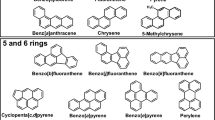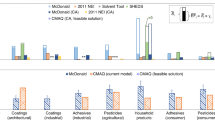Abstract
The US Environmental Protection Agency (EPA) initiated the Small Engine Exposure Study (SEES) to evaluate potential exposures among users of small, gasoline-powered, non-road spark-ignition (SI) lawn and garden engines. Equipment tested included riding tractors, walk-behind lawn mowers, string trimmers, and chainsaws. Personal and background air quality measurements were collected on equipment operators for carbon monoxide (CO), particulate matter ⩽2.5 μm in aerodynamic diameter (PM2.5), volatile organic compounds (VOCs), and aldehydes. PM2.5 measurements included continuous and integrated mass, elemental and organic carbon (EC/OC), and trace metals. Aldehyde measurements included speciation for formaldehyde and acetaldehyde. The results demonstrated that equipment operators can experience elevated exposures to CO, PM2.5 and air toxics while operating these engines. Ten-second average CO personal exposures spanned over two orders of magnitude, with short-term concentrations exceeding 120 p.p.m. for some engine applications tested. PM2.5 concentrations averaged over each engine test period also spanned two orders of magnitude. The results also suggest that health standards, such as the CO and PM2.5 National Ambient Air Quality Standards (NAAQS), may be exceeded for certain equipment types under certain operating scenarios. Aldehyde measurements suggested exposures from primary engine emissions that exceed typical ambient concentrations, but do not exceed occupational health standards. Continuous exposure measurements illustrated the important role of the operator's activity and environmental conditions in affecting exposure levels.
This is a preview of subscription content, access via your institution
Access options
Subscribe to this journal
Receive 6 print issues and online access
$259.00 per year
only $43.17 per issue
Buy this article
- Purchase on Springer Link
- Instant access to full article PDF
Prices may be subject to local taxes which are calculated during checkout







Similar content being viewed by others
References
Birch M.E., and Cary R.A. Elemental carbon-based method for monitoring occupational exposures to particulate diesel exhaust. Aerosol Sci Technol 1996: 25(3): 221–241.
Bunger J., Bombosch F., Mesecke U., and Hallier E. Monitoring and analysis of occupational exposure to chain saw exhausts. Am Ind Hyg Assoc J 1997: 58: 747–751.
Cadle S.H., Mulawa P., Hunsanger E.C., Nelson K., Ragazzi R.A., Barrett R., Gallagher G.L., Lawson D.R., Knapp K.T., and Snow R. Light-duty motor vehicle exhaust particulate matter measurement in the Denver, Colorado, area. J Air Waste Manage Assoc 1999: 49: PM-164–PM-174.
Chung C.W., Morandi M.T., Stock T.H., and Afshar M. Evaluation of a passive sampler for volatile organic compounds at ppb concentrations, varying temperatures, and humidities with 24-h exposures. 2. Sampler performance. Environ Sci Technol 1999: 33(20): 3666–3671.
Durbin T.D., Smith M.R., Norbeck J.M., and Truex T.J. Population density, particulate emission characterization, and impact on the particulate inventory of smoking vehicles in the South coast air quality management district. J Air Waste Manage Assoc 1999: 49: 28–38.
United States Federal Register. Number 60 (March 30), 1999: 64: 15208–15254.
Gabele P. Exhaust emissions from four-stroke lawn mower engines. Air Waste Manage Assoc 1997: 47: 945–952.
Kleeman M.J., Schauer J.J., and Cass G.R. Size and composition distribution of fine particulate matter emitted from motor vehicles. Environ Sci Technol 2000: 34: 1132–1142.
Malm W.C., Sisler J.F., Huffman D., Eldred R.A., and Cahill T.A. Spatial and seasonal trends in particle concentration and optical extinction in the United States. J Geophys Res 1994: 99.
Priest M.W., Williams D.J., and Bridgman H.A. Emissions from in-use lawn-mowers in Australia. Atmos Environ 2000: 34: 657–664.
Snow R.F., Crews W.S., and Braddock J.N. Characterization of Emissions from Small, Hand-held, In-Use, 2-Cycle Engines: Final Report, EPA/600/X-04/191, 2004.
United States Environmental Protection Agency. Final Regulatory Impact Analysis: Control of Emissions from Nonroad Diesel Engines, EPA 420-R-04-007, 2004.
Yumlu S.V. Lawn Mower Use and Emissions in Canada. Report EPS 5/AP/6 for the Environmental Protection Service Environment, Canada, 1994.
Acknowledgements
We acknowledge the efforts of others who contributed to this project. Carl Scarbro, Chris Lieske, and Phil Carlson of the US Environmental Protection Agency's (EPA) Office of Transportation and Air Quality (OTAQ) assisted in identifying appropriate equipment for testing, and procuring the actual equipment tested. Ron Williams and Don Whitaker of EPA's Office of Research and Development and Chad Bailey of OTAQ provided valuable assistance in designing and implementing the study.
Author information
Authors and Affiliations
Corresponding author
Additional information
Disclaimer
The United States Environmental Protection Agency through its Office of Research and Development funded and managed the research described here under Contract 68-D-00-206 to ManTech Environmental Technology Incorporated. It has been subjected to Agency review and approved for publication.
Rights and permissions
About this article
Cite this article
Baldauf, R., Fortune, C., Weinstein, J. et al. Air contaminant exposures during the operation of lawn and garden equipment. J Expo Sci Environ Epidemiol 16, 362–370 (2006). https://doi.org/10.1038/sj.jes.7500471
Received:
Accepted:
Published:
Issue Date:
DOI: https://doi.org/10.1038/sj.jes.7500471
Keywords
This article is cited by
-
Legal regulations of restrictions of air pollution made by non-road mobile machinery—the case study for Europe: a review
Environmental Science and Pollution Research (2018)
-
Small Things Make a Big Difference
Sports Medicine (2012)



